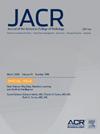ACR 适宜性标准® 非静脉性上消化道出血:2024 年更新。
IF 4
3区 医学
Q1 RADIOLOGY, NUCLEAR MEDICINE & MEDICAL IMAGING
引用次数: 0
摘要
本文件总结了在疑似或已知非静脉性上消化道出血(UGIB)患者的五种临床情况下选择初始影像学检查的相关文献。这些临床情况包括:未进行内镜检查的疑似非静脉性上消化道出血;内镜确诊的非静脉性上消化道出血,出血源明确但无法治疗或内镜治疗后继续出血;内镜确诊的非静脉性上消化道出血,出血源不明确;内镜检查阴性的疑似非静脉性上消化道出血;以及内镜检查禁忌的手术后或创伤后非静脉性上消化道出血。成像方式在每种临床情况下的适宜性分为通常适宜、可能适宜和通常不适宜,以帮助在非静脉性 UGIB 的相应临床情况下选择最适宜的成像方式。美国放射学会适宜性标准是针对特定临床情况的循证指南,每年由一个多学科专家小组进行审查。指南的制定和修订过程支持对同行评审期刊上的医学文献进行系统分析。已确立的方法原则,如 "建议评估、发展和评价分级"(GRADE),被用来评估证据。兰德/加州大学洛杉矶分校《适宜性方法用户手册》提供了确定特定临床情况下成像和治疗程序适宜性的方法。在缺乏同行评议文献或文献模棱两可的情况下,专家可能是制定建议的主要证据来源。本文章由计算机程序翻译,如有差异,请以英文原文为准。
ACR Appropriateness Criteria® Nonvariceal Upper Gastrointestinal Bleeding: 2024 Update
This document summarizes the relevant literature for the selection of the initial imaging in five clinical scenarios in patients with suspected or known nonvariceal upper gastrointestinal bleeding (UGIB). These clinical scenarios include suspected nonvariceal UGIB without endoscopy performed; endoscopically confirmed nonvariceal UGIB with clear source but treatment not possible or continued bleeding after endoscopic treatment; endoscopically confirmed nonvariceal UGIB without a confirmed source; suspected nonvariceal UGIB with negative endoscopy; and postsurgical or post-traumatic nonvariceal UGIB when endoscopy is contraindicated. The appropriateness of imaging modalities as they apply to each clinical scenario is rated as usually appropriate, may be appropriate, and usually not appropriate to assist the selection of the most appropriate imaging modality in the corresponding clinical scenarios of nonvariceal UGIB.
The American College of Radiology Appropriateness Criteria are evidence-based guidelines for specific clinical conditions that are reviewed annually by a multidisciplinary expert panel. The guideline development and revision process support the systematic analysis of the medical literature from peer reviewed journals. Established methodology principles such as Grading of Recommendations Assessment, Development, and Evaluation or GRADE are adapted to evaluate the evidence. The RAND/UCLA Appropriateness Method User Manual provides the methodology to determine the appropriateness of imaging and treatment procedures for specific clinical scenarios. In those instances where peer reviewed literature is lacking or equivocal, experts may be the primary evidentiary source available to formulate a recommendation.
求助全文
通过发布文献求助,成功后即可免费获取论文全文。
去求助
来源期刊

Journal of the American College of Radiology
RADIOLOGY, NUCLEAR MEDICINE & MEDICAL IMAGING-
CiteScore
6.30
自引率
8.90%
发文量
312
审稿时长
34 days
期刊介绍:
The official journal of the American College of Radiology, JACR informs its readers of timely, pertinent, and important topics affecting the practice of diagnostic radiologists, interventional radiologists, medical physicists, and radiation oncologists. In so doing, JACR improves their practices and helps optimize their role in the health care system. By providing a forum for informative, well-written articles on health policy, clinical practice, practice management, data science, and education, JACR engages readers in a dialogue that ultimately benefits patient care.
 求助内容:
求助内容: 应助结果提醒方式:
应助结果提醒方式:


